Did you know that during the height of the Manila Galleon trade, over 1,000 ships sailed annually between the Philippines and Mexico? This bustling network of commerce connected distant cultures and laid the foundation for modern economic systems. The Philippines, with its strategic location, became a hub for goods and services, shaping its identity as a key player in regional trade.
Archaeological discoveries have revealed how early barter systems evolved into sophisticated methods of trading. From the Maritime Jade Road to the Sulu Zone, these routes not only facilitated the exchange of products but also fostered cultural connections across borders. Understanding this history helps us appreciate how ancient systems influenced today’s economy.
This article explores the evolution of these routes, their impact on the Philippines, and how they continue to shape global relationships. Dive in to uncover the fascinating story of how trade transformed a country and its neighbors.
Key Takeaways
- The Manila Galleon trade connected the Philippines and Mexico for over 250 years.
- Archaeological findings highlight the evolution of early barter systems.
- Trade routes fostered cultural and economic connections across borders.
- The Philippines played a central role in regional commerce.
- Understanding ancient trade helps explain modern economic systems.
Introduction to Ancient Trade Routes and Their Global Impact
The exchange of goods and ideas shaped the world long before modern economies existed. From simple barter systems to the use of credit, early forms of trade laid the foundation for today’s global economy. These networks connected distant lands, fostering not only economic but also cultural exchanges.
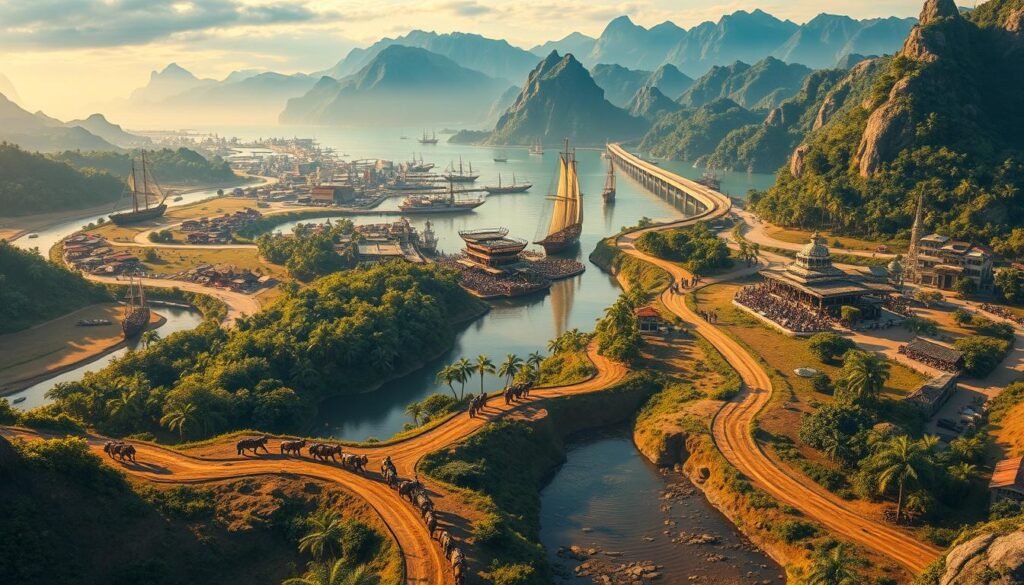
Defining Trade and Its Early Forms
In its simplest form, trade involved the exchange of goods and services. Early societies relied on barter, where items like grain, tools, and livestock were swapped directly. Over time, credit systems emerged, allowing people to trade without immediate payment. This evolution marked the beginning of more complex economic systems.
Overview of Economic and Cultural Exchanges
Trade routes like the Silk Road and the Maritime Jade Road were more than just pathways for goods. They became channels for cultural interaction, spreading art, religion, and technology. For example, the Silk Road connected China to the Mediterranean, enabling the flow of silk, spices, and ideas.
Written accounting and the development of currency further advanced trade. These tools allowed for better record-keeping and standardized value, making exchanges more efficient. Today, the principles of these early systems continue to influence global economic growth.
Historical Evolution of Trade in the Philippines and Beyond
Long before modern economies, early societies relied on simple exchanges to meet their needs. These interactions laid the groundwork for the complex systems we see today. The Philippines, with its rich history, played a significant role in this evolution.
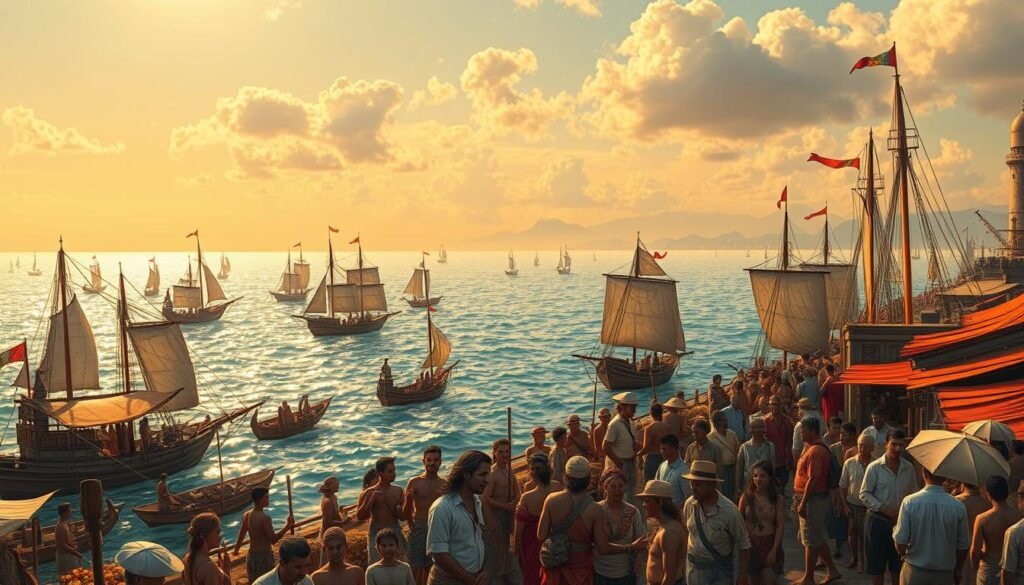
Prehistoric Barter Systems and the Birth of Commerce
In prehistoric times, people exchanged goods directly through barter. Items like tools, food, and raw materials were swapped based on need. This system was simple but effective for small communities.
Archaeological evidence shows that obsidian, a volcanic glass, was a highly valued product. Found in New Guinea as early as 17,000 BCE, it was traded across long distances. This early form of commerce highlights the importance of certain goods in ancient societies.
From Obsidian Exchanges to Early Written Accounting
As societies grew, so did their methods of exchange. Tokens and early forms of currency replaced direct barter. This shift allowed for more complex transactions and better record-keeping.
Written records began to document these exchanges, providing a clearer picture of early economic systems. For example, ancient civilizations used clay tablets to track goods and services. This innovation marked a significant step in the development of trade.
These early practices set the stage for more advanced systems in the Philippines and beyond. Understanding this history helps us appreciate the roots of modern economy.
For more insights into how these early systems influenced the region, visit this detailed analysis.
Maritime Trade Networks and the Maritime Jade Road
The vast oceans of Southeast Asia were once bustling highways for ancient seafarers. These waters became the foundation for some of the earliest maritime trade networks, connecting distant regions and fostering cultural and economic exchanges. Among these, the Maritime Jade Road stands out as a remarkable example of early innovation.
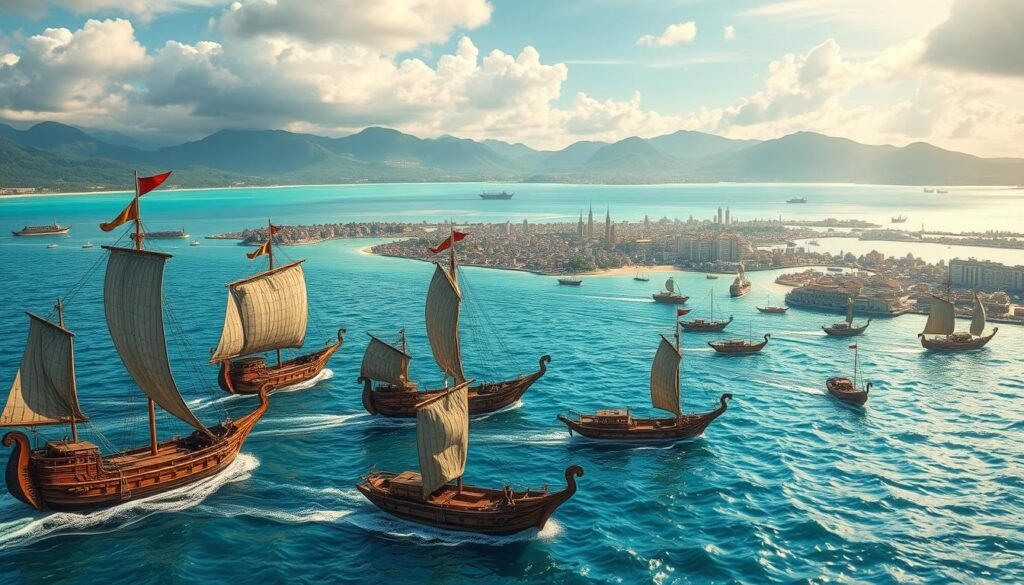
The Role of Austronesian Peoples in Sea-Based Trade
Austronesian peoples were pioneers in sea-based commerce. Their mastery of navigation allowed them to connect Taiwan, the Philippines, and other regions as early as 2000 BCE. These seafarers transported goods like jade, spices, and ceramics, creating a network that spanned thousands of miles.
Archaeological evidence, such as jade artifacts found in the Philippines, highlights their contributions. These discoveries show how Austronesian traders facilitated the exchange of valuable resources, laying the groundwork for more complex systems of exchange.
How the Maritime Jade Road Shaped Regional Ties
The Maritime Jade Road was more than just a trade route; it was a bridge between cultures. This network connected Taiwan, the Philippines, and beyond, enabling the flow of goods and ideas. Jade, in particular, held significant cultural and economic value, symbolizing wealth and power.
This network also strengthened regional ties. Communities along the route shared technologies, traditions, and resources, fostering a sense of unity. The impact of these connections can still be seen today in the cultural similarities across Southeast Asia.
“The Maritime Jade Road was a testament to the ingenuity of early seafarers, shaping the economic and cultural landscape of the region.”
| Key Periods | Archaeological Evidence | Impact |
|---|---|---|
| 2000 BCE – 500 CE | Jade artifacts in the Philippines | Cultural and economic exchanges |
| 600 BCE – 400 CE | Bronze drums from Dong Son culture | Spread of technology and art |
| 689 CE – 988 CE | Butuan boat burials | Advancements in shipbuilding |
The legacy of these early maritime networks continues to influence modern international trade practices. By understanding their history, we gain valuable insights into the roots of global commerce and the enduring connections between nations.
Trade: Concepts, Mechanisms, and Modern Interpretations
Understanding the principles of economic exchange reveals how nations grow and prosper. At the heart of this lies the Principle of Comparative Advantage, a theory introduced by David Ricardo in 1817. This concept explains why countries specialize in producing certain goods and services, even if they are not the most efficient at it.
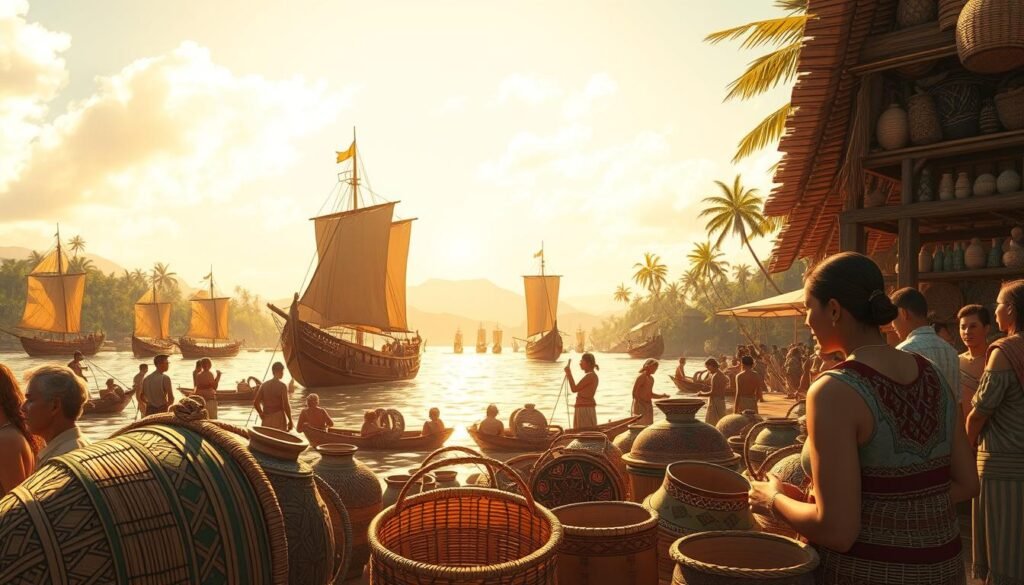
The Principle of Comparative Advantage
Comparative advantage suggests that a country should focus on producing goods it can make more efficiently than others. For example, if Country A can produce wheat better than Country B, and Country B excels in making textiles, both benefit by specializing and trading. This creates a win-win situation, boosting economic growth for both nations.
This principle is still relevant today. It helps explain why some countries dominate specific industries, like Japan in electronics or Germany in automobiles. By focusing on their strengths, they maximize their market potential and create jobs.
Free Trade vs. Protectionism in Historical Context
Throughout history, the debate between free trade and protectionism has shaped economic policy. Free trade encourages open markets, allowing goods and services to flow freely between countries. Protectionism, on the other hand, uses tariffs and barriers to shield domestic industries from foreign competition.
In the 19th century, Britain championed free trade, leading to its dominance in global commerce. Meanwhile, the U.S. used protectionist policies to nurture its industries during its early years. These historical examples show how different approaches can influence a nation’s economic trajectory.
“Free trade is not just an economic policy; it’s a philosophy that promotes mutual benefit and global cooperation.”
Today, these concepts continue to shape international business practices. By understanding their roots, we can better navigate the complexities of modern economic systems and foster sustainable growth.
Economic Impact of Trade on the Philippines
The Philippines has long been a focal point for economic activity, driven by its strategic location and vibrant trade networks. These networks have not only connected the country to global markets but also fueled local business growth and innovation.
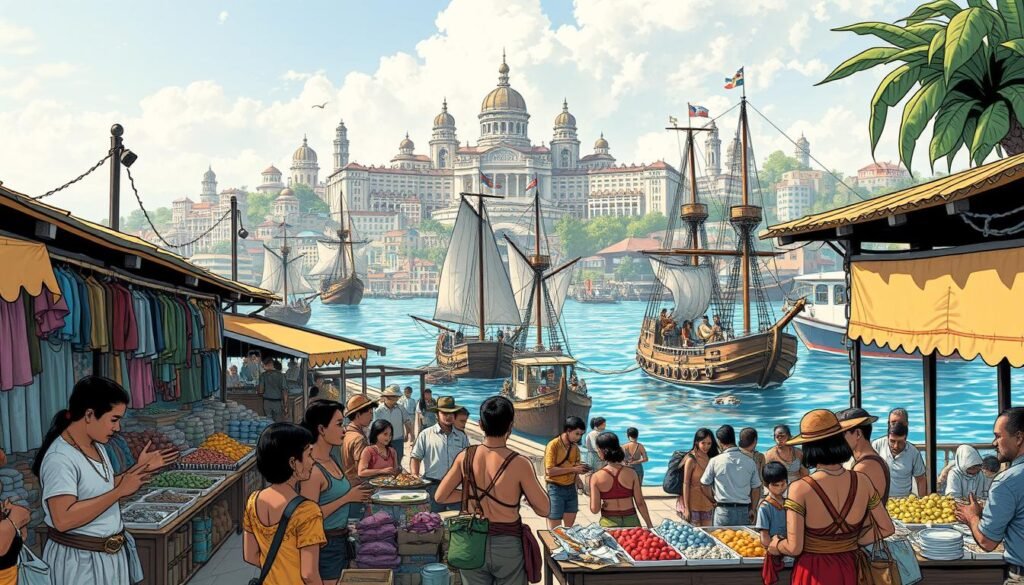
Influence on Local Market Growth and Business Opportunities
International and regional trade has significantly boosted the Philippine market. Increased access to global goods and services has expanded consumer choices and driven competitive pricing. For example, local entrepreneurs have thrived by leveraging broader trade networks to source materials and reach new customers.
Free trade policies have played a crucial role in shaping the national economy. By reducing barriers, these policies have attracted foreign investment and encouraged business ventures. The EU’s Generalised Scheme of Preferences plus (GSP+) has allowed Philippine products to enter European markets tariff-free, further boosting exports.
- Trade has created numerous job opportunities, particularly in manufacturing and agriculture.
- Regional economic development has been enhanced through increased investment in infrastructure.
- Historical trade practices continue to influence modern local markets, fostering resilience and adaptability.
For more insights into how trade shapes the Philippine economy, visit this detailed analysis.
“Trade is not just about goods; it’s about creating opportunities and fostering growth for communities.”
As the Philippines continues to diversify its economic partnerships, it remains a key player in regional and global trade. For a deeper understanding of its evolving trade strategy, explore this comprehensive report.
Regional Trade Policies and Government Influence
Government actions, from tariffs to subsidies, have historically played a pivotal role in shaping trade dynamics. These policies not only protect domestic industries but also influence global market relationships. Understanding their impact helps explain the evolution of international commerce.
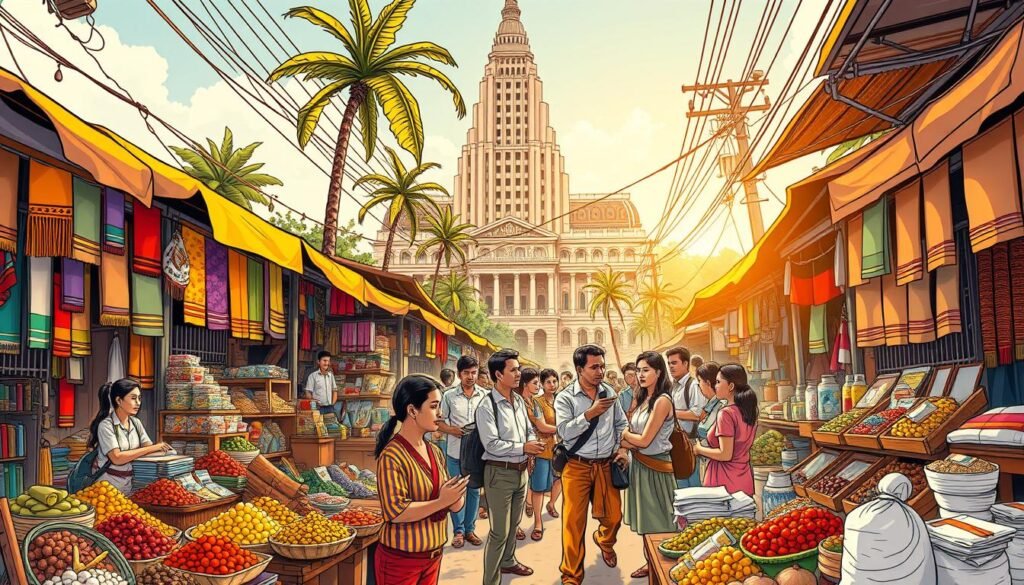
Trade Barriers, Tariffs, and Subsidies
Tariffs and subsidies are among the most common tools used by governments to regulate trade. Tariffs, or taxes on imports, aim to make foreign goods more expensive, encouraging consumers to buy local products. Subsidies, on the other hand, provide financial support to domestic industries, helping them compete globally.
Historically, these measures have been used to protect emerging industries. For example, in the 19th century, the U.S. imposed high tariffs to nurture its manufacturing sector. Today, many countries continue to use subsidies to support agriculture and technology.
Policies Shaping Modern Trade Relations
Modern trade policies often reflect a balance between protectionism and free trade. Regional agreements, like the ASEAN Free Trade Area, aim to reduce barriers and promote economic cooperation. These agreements foster cross-border business opportunities and strengthen regional ties.
However, disputes over tariffs and subsidies remain common. For instance, the ongoing tensions between the U.S. and China highlight the challenges of balancing domestic interests with global market demands. Understanding these dynamics is crucial for navigating today’s complex trade environment.
“Trade policies are not just about economics; they shape the political and social fabric of nations.”
For a deeper dive into how trade policies influence global dynamics, explore trade policy dynamics.
Case Studies: Historical and Modern Trading Examples
Archaeological findings and modern business strategies reveal the enduring legacy of ancient trade networks. From the exchange of obsidian in prehistoric times to today’s global supply chains, these systems have shaped economies and cultures. This section explores key case studies that highlight the evolution of trade and its lasting impact.

Ancient Trade Evidence from Archaeological Discoveries
Archaeological discoveries provide a window into early trade practices. For example, obsidian artifacts found in the Philippines and New Guinea show how this volcanic glass was traded across vast distances as early as 17,000 BCE. These findings highlight the importance of certain goods in ancient societies.
Another example is the Maritime Jade Road, which connected Taiwan, the Philippines, and other regions. Jade artifacts unearthed in the Philippines demonstrate the cultural and economic value of this network. These discoveries underscore how early trade routes fostered regional ties and economic growth.
Modern Business Practices Influenced by Trade Networks
Modern businesses continue to draw inspiration from historical trade principles. For instance, companies like Nestlé and Unilever have built global supply chains that mirror ancient trade routes. By sourcing raw materials from multiple countries, they ensure efficiency and resilience.
Another example is the rise of e-commerce platforms like Shopee and Lazada, which have transformed traditional trading methods. These platforms connect buyers and sellers across borders, creating a digital marketplace that echoes the interconnectedness of ancient trade networks.
“Studying the past helps us understand the future of trade and its potential to drive economic growth.”
For more insights into how trade dynamics shape modern businesses, explore this detailed analysis.
Analyzing Global Trade Trends and Future Prospects
Global trade has always been a cornerstone of economic development, shaping nations and fostering connections across borders. Today, it continues to drive growth and innovation, with emerging markets playing a pivotal role. From foreign direct investment (FDI) to technological advancements, the landscape of international commerce is evolving rapidly.
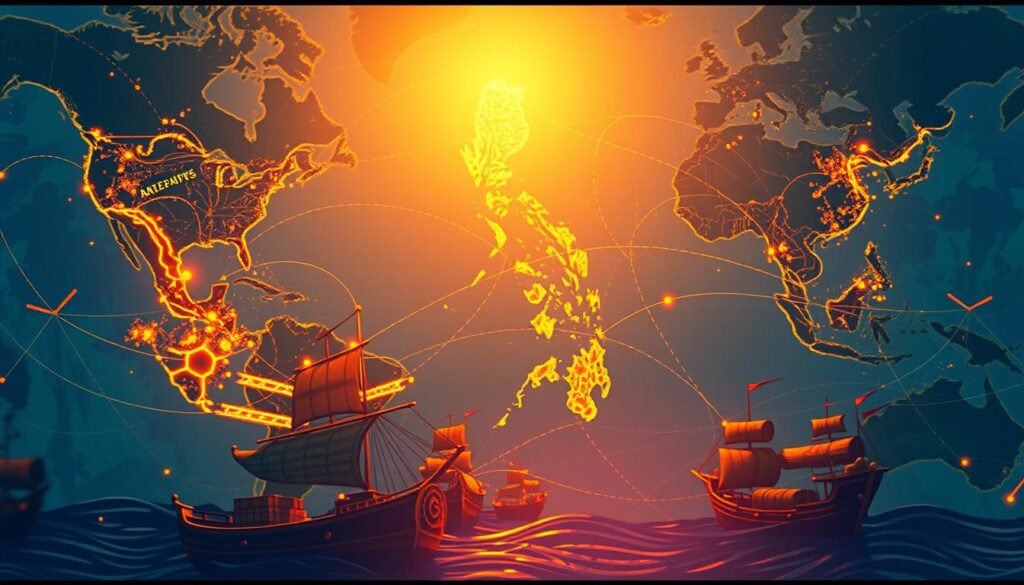
Impact of International Trade on Economic Growth
International trade has been a driving force behind economic expansion worldwide. By connecting markets, it enables countries to specialize in producing goods and services where they have a comparative advantage. This boosts efficiency and creates jobs, contributing to overall prosperity.
Foreign direct investment (FDI) has also played a crucial role. According to the World Bank, FDI inflows have significantly impacted developing economies, fostering innovation and infrastructure development. For example, countries like the Philippines have benefited from increased investments in technology and manufacturing.
- Trade has created millions of jobs globally, particularly in emerging markets.
- Technological advancements have streamlined logistics, reducing costs and improving efficiency.
- Regional trade agreements have strengthened economic ties, promoting stability and growth.
However, challenges remain. Trade barriers and geopolitical tensions can disrupt supply chains, affecting global markets. For instance, the ongoing shifts in US trade policy have impacted countries with significant trade surpluses, such as China and Vietnam.
“Global trade is not just about goods; it’s about creating opportunities and fostering growth for communities.”
Looking ahead, the future of trade is shaped by digitalization and sustainability. E-commerce and digital platforms are transforming traditional trading methods, while green initiatives are driving demand for eco-friendly products. For more insights into long-term growth prospects, explore this comprehensive report.
As global markets continue to evolve, understanding these trends is essential for navigating the complexities of modern commerce. By embracing innovation and fostering cooperation, nations can unlock new opportunities and build a more resilient global economy.
Conclusion
From ancient barter systems to today’s global networks, trade has been a driving force in shaping economies and cultures. The Philippines, with its strategic location, has played a pivotal role in regional and international commerce, fostering connections that transcend borders.
Historical maritime networks like the Maritime Jade Road laid the foundation for modern trade practices. These routes not only facilitated the exchange of goods but also strengthened cultural ties across Southeast Asia. Economic theories such as comparative advantage continue to influence global markets, highlighting the importance of specialization and cooperation.
Government policies and regional agreements have further shaped the country’s economic landscape. By reducing barriers and promoting free trade, nations can unlock new opportunities for growth and innovation. Understanding these dynamics helps us appreciate the enduring legacy of ancient trade systems and their impact on modern economies.
For a deeper dive into the complexities of trade agreements, explore this comprehensive analysis.
FAQ
What were the earliest forms of trade in the Philippines?
The earliest forms included barter systems, where goods like obsidian and agricultural products were exchanged among communities.
How did the Maritime Jade Road influence regional ties?
It connected Southeast Asia, Taiwan, and the Philippines, fostering cultural and economic exchanges through sea-based trade routes.
What is the principle of comparative advantage in trade?
It refers to the ability of a country to produce goods more efficiently than others, leading to mutual benefits through specialization and exchange.
How did trade impact the growth of local markets in the Philippines?
It stimulated business opportunities, increased access to diverse goods, and encouraged economic development in local communities.
What role did Austronesian peoples play in maritime trade?
They were skilled navigators who established extensive sea routes, facilitating the exchange of goods and ideas across regions.
What are trade barriers, and how do they affect commerce?
Trade barriers, such as tariffs and subsidies, can restrict the flow of goods, impacting prices and market competition.
Can you provide an example of ancient trade evidence in the Philippines?
Archaeological discoveries, like pottery and jade artifacts, highlight the Philippines’ role in early regional trade networks.
How does international trade influence economic growth?
It boosts economies by expanding markets, creating jobs, and fostering innovation through global collaboration.
What is the difference between free trade and protectionism?
Free trade promotes open markets with minimal restrictions, while protectionism uses tariffs and barriers to shield domestic industries.
How did ancient trade routes shape cultural exchanges?
They facilitated the spread of ideas, traditions, and technologies, enriching the cultural heritage of connected regions.
Source Links
- No title found
- Unearthing our history – Tulay 橋
- The Silk Road and Ancient Trade: Crash Course World History #9
- Ancient Trade Routes: Connecting Civilizations Across Continents
- Microsoft Word – (12) Parcon-Santos – FINAL.doc
- Maritime Trade in the Philippines During the 15th Century CE
- An Introduction To
- Maritime Silk Road
- 5.2: The Maritime and Overland Silk Road (200 BCE – 200 CE)
- Maritime Silk Routes- The Story of the Oldest Trade Routes
- What Is International Trade Theory?
- 2.1 What Is International Trade Theory?
- EU trade relations with the Philippines
- No title found
- WTO | Regional Trade Agreements
- Chapter 3: Trade Agreements and Economic Theory
- WTO |Managing the Challenges of WTO Participation: Case Studies
- Trade Wars: History, Pros & Cons, and U.S.-China Example
- Trade and Globalization
- Global Trade Update (December 2024)
- Globalization in transition: The future of trade and value chains
- Conclusion – Trade and the Environment
- Conclusion – International Trade, Investment, and the Sustainable Development Goals

